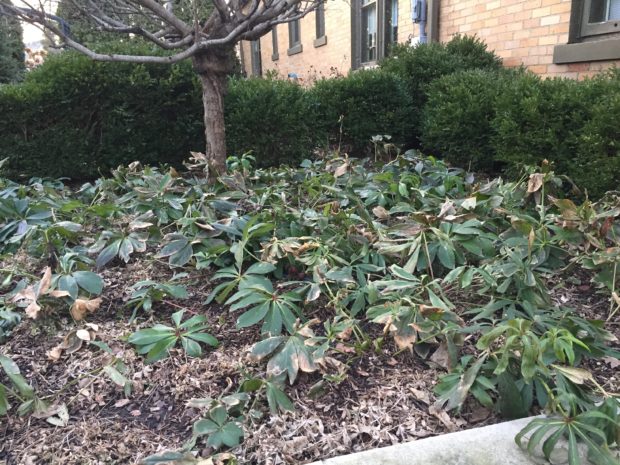 Plants are very specific about what soil, light and water conditions they need to thrive. Any gardener who has moved a sulking plant around 3 or 4 times before striking pay dirt understands this. It is simple to spot a plant that is unhappy. Figuring out the cause of the trouble can be tough, as there are so many factors that come in to play. There are those plants, in defiance of every good intention and effort to find them a suitable home, that fail to prosper. I have killed outright plenty of plants. Given that every plant has a strong will to live and reproduce, those failures are frustrating and embarrassing. Figuring out what a plant needs to thrive is 2 parts science, 2 parts luck, and 6 parts good instincts. The hellebores in the above picture look unhappy, as they always do in February. They like the filtered sun, protection from wind, the friable soil and regular moisture that is available to them here in the growing season. They have what they need to thrive. What they do not like in February is the cold. Before any plant in a Michigan garden can thrive, it has to be able to survive our winters.
Plants are very specific about what soil, light and water conditions they need to thrive. Any gardener who has moved a sulking plant around 3 or 4 times before striking pay dirt understands this. It is simple to spot a plant that is unhappy. Figuring out the cause of the trouble can be tough, as there are so many factors that come in to play. There are those plants, in defiance of every good intention and effort to find them a suitable home, that fail to prosper. I have killed outright plenty of plants. Given that every plant has a strong will to live and reproduce, those failures are frustrating and embarrassing. Figuring out what a plant needs to thrive is 2 parts science, 2 parts luck, and 6 parts good instincts. The hellebores in the above picture look unhappy, as they always do in February. They like the filtered sun, protection from wind, the friable soil and regular moisture that is available to them here in the growing season. They have what they need to thrive. What they do not like in February is the cold. Before any plant in a Michigan garden can thrive, it has to be able to survive our winters.
Plant hardiness zones indicate a worst case low temperature for different parts of the country. The USDA, in compiling data from weather stations, and factoring in mitigating circumstances which can influence low temperatures, has produced a plant hardiness map. Interested in that map making process? mapping plant hardiness It gives gardeners an idea of what the lowest average winter temperature can be in a given area. The hardiness map is a guide that can help gardeners select plants which are appropriate for their area. My area is at best a zone 6, and at worst, a zone 5b. This means that plants that are able to withstand low temperatures in the -15 to -10 degrees should be able to survive in my garden. That includes these ratty looking hellebores. Last year’s foliage may be burned from cold and wind, but they are very much alive, and waiting for some signs of spring.
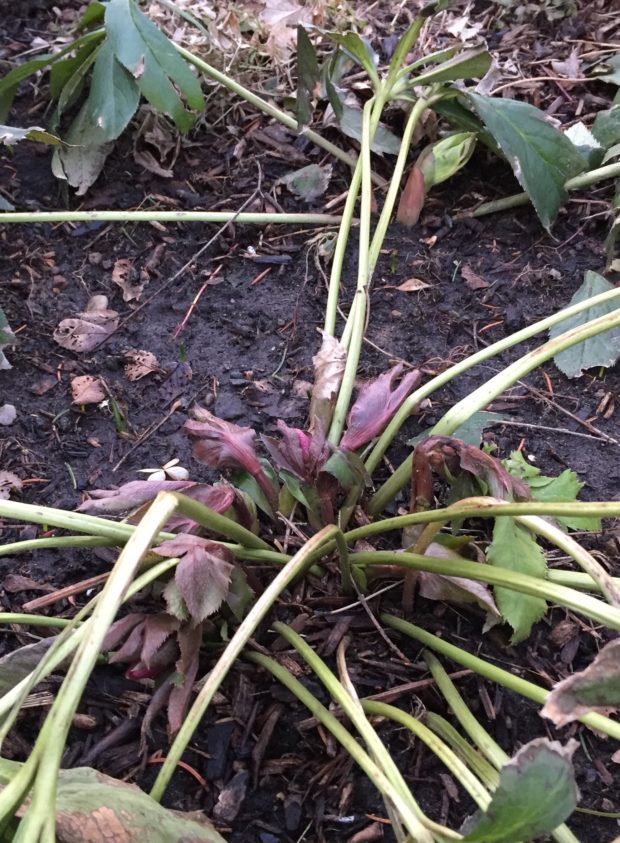 The key to survival in very cold regions is dependent on that plant slowly going dormant over the metabolic slow down that we call fall, and a constant deep dormancy throughout the period of very cold weather. What the hardiness zone map does not provide for are weather events out of the norm. We have had temperatures in the 50’s and 60’s for a week. On February 18, the record high for that day of 62 degrees set in 1976 was eclipsed by a 65 degree day. One or two days of weather that warm might not affect any plants that are still dormant. The frost is deep in the ground. But the days are staying warm. We have a low of 56 forecast for overnight tonight. Now I am starting to fret. It is too warm, way too early. Under that winter foliage, I see signs that the hellebore flower stalks have begun to emerge.
The key to survival in very cold regions is dependent on that plant slowly going dormant over the metabolic slow down that we call fall, and a constant deep dormancy throughout the period of very cold weather. What the hardiness zone map does not provide for are weather events out of the norm. We have had temperatures in the 50’s and 60’s for a week. On February 18, the record high for that day of 62 degrees set in 1976 was eclipsed by a 65 degree day. One or two days of weather that warm might not affect any plants that are still dormant. The frost is deep in the ground. But the days are staying warm. We have a low of 56 forecast for overnight tonight. Now I am starting to fret. It is too warm, way too early. Under that winter foliage, I see signs that the hellebore flower stalks have begun to emerge.
 A plant breaks dormancy for a constellation of reasons. Longer day length and warming temperatures are key. No plant reacts instantly to a brief change in conditions. But a change that persists is an invitation to wake up. Hellebores are greatly prized by gardeners everywhere. I do favor helleborus orientalis hybrids for my zone. This group of hellebores, now known as helleborus hybridus, are bred from hellebores commonly known as Lenten roses. This group generally begins blooming in April in my zone 6 garden. Hellebore hybrids featuring the genes of Helleborus niger, commonly known as the Christmas rose, naturally bloom at a time which is winter in my garden. Do I have inter generic hellebores in my garden that would prosper better in zones further south? Of course I do. I am always pushing my luck. I have had great success growing plants marginal to my zone. But nature is unpredictable. Nor does she care a whit for me and my love for my garden.
A plant breaks dormancy for a constellation of reasons. Longer day length and warming temperatures are key. No plant reacts instantly to a brief change in conditions. But a change that persists is an invitation to wake up. Hellebores are greatly prized by gardeners everywhere. I do favor helleborus orientalis hybrids for my zone. This group of hellebores, now known as helleborus hybridus, are bred from hellebores commonly known as Lenten roses. This group generally begins blooming in April in my zone 6 garden. Hellebore hybrids featuring the genes of Helleborus niger, commonly known as the Christmas rose, naturally bloom at a time which is winter in my garden. Do I have inter generic hellebores in my garden that would prosper better in zones further south? Of course I do. I am always pushing my luck. I have had great success growing plants marginal to my zone. But nature is unpredictable. Nor does she care a whit for me and my love for my garden.
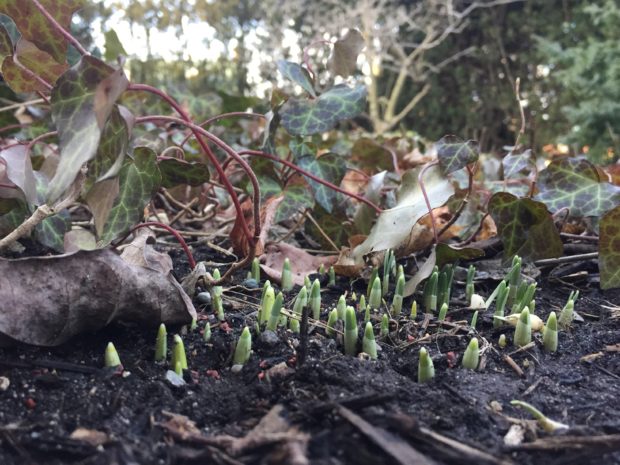 Our bitter 2014 winter turned my zone 6 into a battle zone 4. None of my magnolias bloomed. My parrotias sustained extensive die back to their upper branches. My roses were killed back to within a foot of the ground plane. My clematis sputtered. My 20 year old boxwood had unbearable damage. It was a sobering experience, to say the least. Any plant marginal to my plant hardiness zone suffered damage of one sort or another. The winter of 2015 might have been worse. On February 20, 2015, the temperature in Roscommon Michigan was -39 degrees. The statewide average for that day was 18.5 degrees below zero. The damage done to evergreens these two back to back vicious winters was extensive. But those plants that were safely dormant managed to survive. The snow drops showing their faces yesterday worry me. 65 degrees in February is an anomaly. The cold weather will return. How much cold can their flowers endure?
Our bitter 2014 winter turned my zone 6 into a battle zone 4. None of my magnolias bloomed. My parrotias sustained extensive die back to their upper branches. My roses were killed back to within a foot of the ground plane. My clematis sputtered. My 20 year old boxwood had unbearable damage. It was a sobering experience, to say the least. Any plant marginal to my plant hardiness zone suffered damage of one sort or another. The winter of 2015 might have been worse. On February 20, 2015, the temperature in Roscommon Michigan was -39 degrees. The statewide average for that day was 18.5 degrees below zero. The damage done to evergreens these two back to back vicious winters was extensive. But those plants that were safely dormant managed to survive. The snow drops showing their faces yesterday worry me. 65 degrees in February is an anomaly. The cold weather will return. How much cold can their flowers endure?
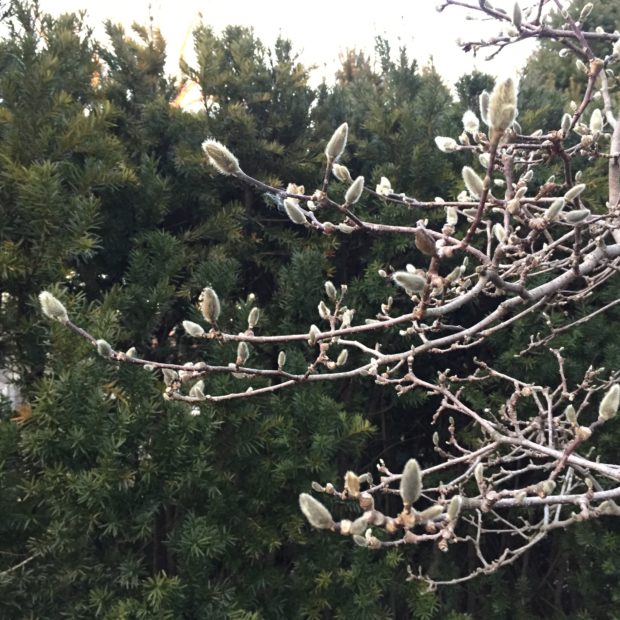 Of course I am anxiously checking all of my early spring blooming plants. This magnolia stellata was a 2 foot tall tree the day I bought my house twenty some years ago. It has prospered where it was planted. It did not bloom in either 2014 or 2015. Its hardiness was sorely tested by a pair of bad winters. The flowering in 2016 was a happening. I am trying to decide if our warm weather is encouraging the buds to swell. Not that I could intervene. Mother nature bats last. I am reading we have some night temperatures in early March in the teens. Though I am ready to wash my hands of winter at the end of February, March is a winter month for us. Any early spring plant which is breaking dormancy right now may not fare so well in March. This is more a worry than a certainty.
Of course I am anxiously checking all of my early spring blooming plants. This magnolia stellata was a 2 foot tall tree the day I bought my house twenty some years ago. It has prospered where it was planted. It did not bloom in either 2014 or 2015. Its hardiness was sorely tested by a pair of bad winters. The flowering in 2016 was a happening. I am trying to decide if our warm weather is encouraging the buds to swell. Not that I could intervene. Mother nature bats last. I am reading we have some night temperatures in early March in the teens. Though I am ready to wash my hands of winter at the end of February, March is a winter month for us. Any early spring plant which is breaking dormancy right now may not fare so well in March. This is more a worry than a certainty.
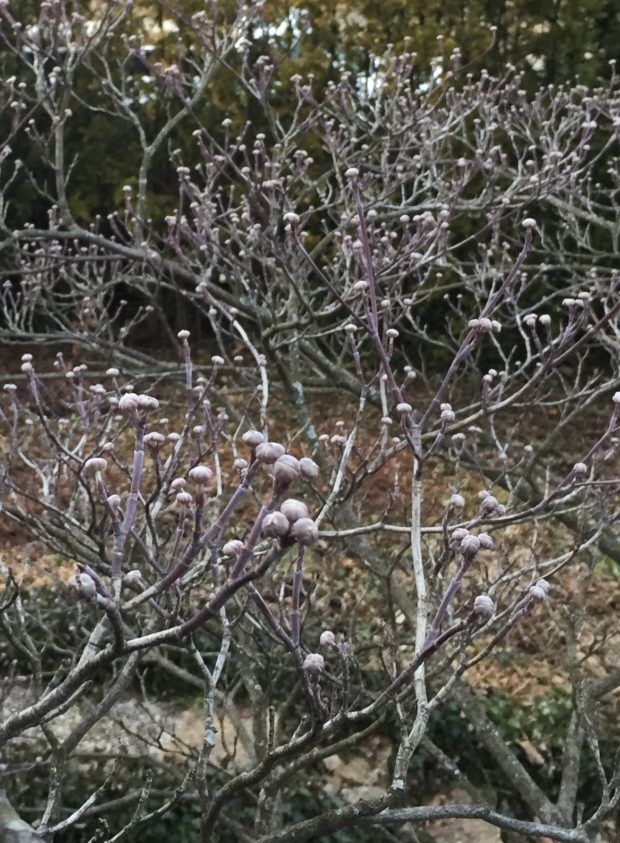 Late this past summer, I replanted my rose garden. Though I know there is a limit to their hardiness in my zone, it is better for me to start over, than to do without. That was a personal decision, not a decision driven by a plant hardiness map. As for the dogwoods, I hope they will be able to endure a freakish warm spell in the middle of winter. No small part of the winter landscape are plants that endure.
Late this past summer, I replanted my rose garden. Though I know there is a limit to their hardiness in my zone, it is better for me to start over, than to do without. That was a personal decision, not a decision driven by a plant hardiness map. As for the dogwoods, I hope they will be able to endure a freakish warm spell in the middle of winter. No small part of the winter landscape are plants that endure.
Deborah,
That photo of the plump buds on your magnolia stellata, makes my heart skip a beat.
Make that two skipped beats. One skip for their gravid beauty and one skip for the peril of a Spring
without magnolias.
My beloved Sweet Bay lost all her leaves this Winter when the temperatures bounced between
single digits and the 60’s here on the East Coast. She’ll recover.
Keeping my fingers crossed for both our mags.
My best,
Kate
Dear Kate, I do have a big love for magnolias. Every troubled spring means I have no flowers. Dang. That goes with the territory, for northern gardeners trying to grow them. I am keeping my fingers crossed too! I know they are marginal in my zone, but I grow them anyway. all the best, Deborah
I feel your anxiety. While the weather was PERFECT for some winter clean up and pruning, seeing the purplish leaf buds on my hydrangneas and watching daffodils/snowdrops stretch an 1 from the ground in a day makes me nervous. I’m praying for our apple and cherry growers.
Dear Nella, I do not know what effect this too warm weather in February will have. It is too early to tell. But I am sure that a perfect spring season only comes once in a while. all the best, Deborah
We have been in the 70’s for almost a week. But tomorrow a snow storm is coming to Iowa. 6 to 12″ in Northen Iowa. We’re in central. So maybe we will miss the most of it, Hope so. So many plants are waking up!!! Darn! As much as I love this weather….its way to early! Mother Nature is confused Too! Love to get your blog in my mail box Deborah! Thank you
Dear Karen, I doubt that Mother nature is confused. But she can be unpredictable, and thoughtless. Unfriendly. I am unhappy about this way too warm spell in February, just like you. Thank you so much for reading! all the best, Deborah
Wondering if you have a suggestion for a somewhat narrow evergreen other than an upright juniper or a yew for vertical winter interest and screening. I’m zone 5 Colorado and we have very limited options.
Dear Abby, your best bet is to consult with a nursery near you. A good nursery will have people in their employ that can help you with plant choices. best, Deborah
Same here in southern Wisconsin. I worry most about farmers and orchardists whose livelihood is affected by freakish weather like this.
Dear Linda, farmers and fruit growers have a stressful life. I admire their courage and their commitment. best, Deborah
I’m in Grosse Pointe and have bud over every one of my hydrangeas. Actually my early bloomers have the least growth on them. I’m going to be out of town from mid March until the end of April. I’m wondering if I should do anything to them before I leave. Is there any way to protect them?
Dear Karen, hydrangeas normally have buds this time of year. If the buds have swelled, and show signs of breaking in to leaf, hope for the best. Mother nature always calls the shots. I doubt there is anything you could do to protect them, except to hope for a mild March. all the best, Deborah
Very informative! I really appreciate it.
Deborah, here in northern NJ, we’ve gone two seasons with no (or just a few) hydrangea blooms. Two years ago, we had a bitterly cold winter with hardly any snow which did in the blooms. And last year, we had a very mild winter — but then in early spring we had an extended period of below freezing temps which once again killed most of the buds. This year, we tried putting a burlap barrier around the plants (open on top) and are hoping it might shield more of the buds on those cold days after a warm spell. You are right that it is ultimately in Mother Nature’s hands and not ours, but we gardeners sure jump through a lot of hoops to grow the things we want to grow! I can so relate to this post…
Dear Deborah,
I completely sympathize with your concerns. We’ve had 60 degree days last week and 12 degrees forcast this week in Utah. The USDA has changed our zone from 6 to 7, which it is not!
Last winter we had a beautiful, warm February and a bitter cold March, with lots of die back. And I don’t try to grow anything marginal! Good Luck!
Sharon
I have left a comment/question 2 times now and does not show on the site. I was wondering if with the hellebore that one should cut off at the ground the old leaves from last year? New flower or leaf buds are appearing- hope the snow does not now kill them off. I was given the plant last year- my 1st to ever hear about a Hellebore, and I have enjoyed your lengthy display of them- thanks, Carol
Dear Carol, I do not recall seeing your previous comments. Sorry! And I also don’t always get to answering comments immediately, especially if I am busy with my crew. The past 2 weeks we have been working like crazy to get the store ready to reopen March 1. At any rate, I do cut the previous year’s leaves from the plants before the bloom stalks come on. I have not cut the leaves off of mine yet, as I am sure we still have really cold weather yet to come. Those leaves do provide a little protection to early emerging stalks. If I get behind cutting back the old leaves, I have to be so careful to cut only the leaves, and not new growth. I would think we would need incredibly cold temperatures to damage them, but if you are worried, you can cover the plant on exceptionally cold nights with a paper grocery bag or old hand towel. all the best, Deborah
Deborah,
I just never saw what I had written even on the list of comments-so you could not have seen it- just did not pick them up I guess. I do realize you must be a very busy person, and it is great you can find time for this column . Thank you for your suggestions. Here in central IN we have had weather extra warm for some time now-up tot he 70’s- my daffodils are budded, Spring Snowflakes in full bloom, Snowdrops, Winter Aconite ( of course it always comes in in Feb),, Scilla. And now below freezing and many things lying down—-going into the low 20’s tonight. :<( I hope t not lose the daffodils! My Helebore is showing flower buds or stlaks- I have not had it past years—something new green is coming up. Thank you! Carol
Dear Carol, Night temperatures in the low 20’s is not good for any plant that has broken dormancy. You might want to cover them. best, Deborah
Hi Deborah,
We have had a very warm winter in Cincinnati. After a string of temps in the 60’s and 70’s, we dropped to 33 on Saturday! We have daffodils, snowdrops, vinca, hellabores and a magnolia stellata in bloom! My hydrangeas and honeysuckle vine have soft, green leaves. I really look forward to a good spring blooming season. I hope we aren’t too disappointed. These past ten years have been a roller coaster ride for sure!